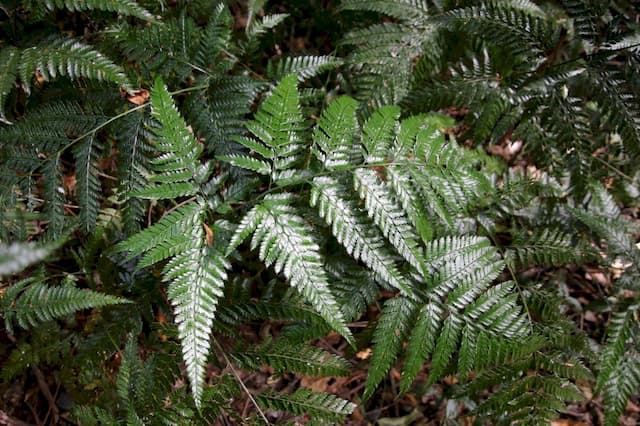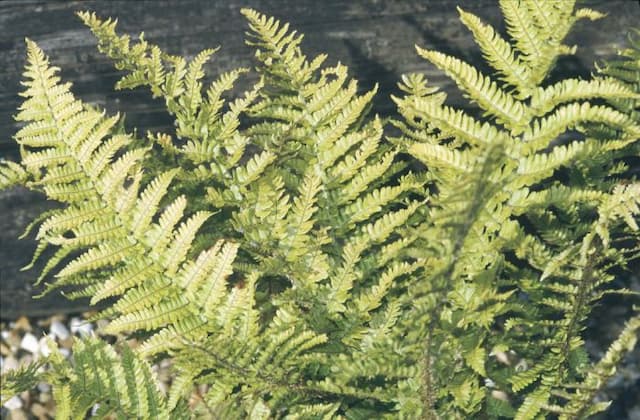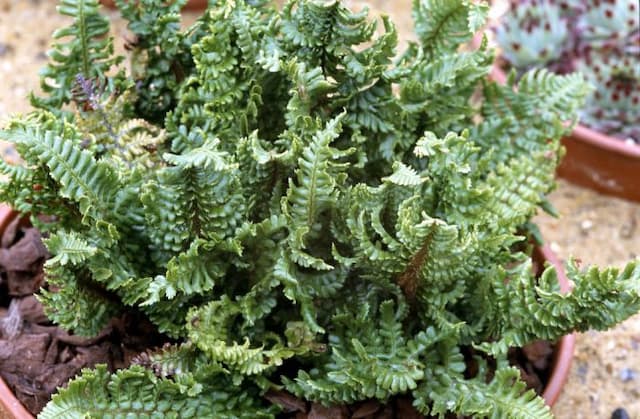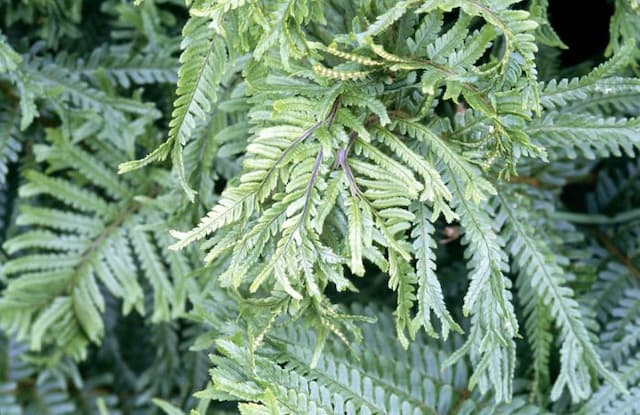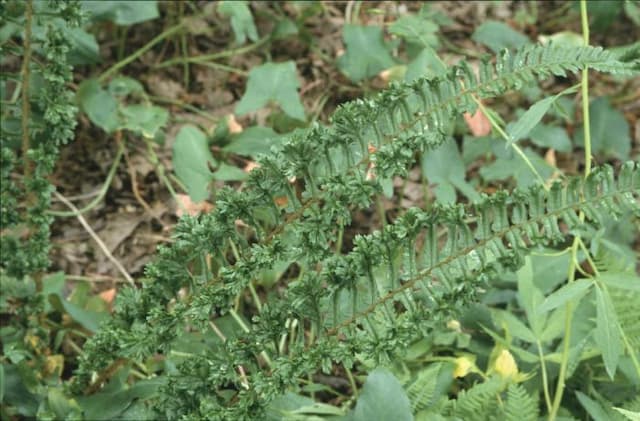Southern Wood Fern Dryopteris ludoviciana

ABOUT
The plant known as the Southern Wood Fern features a lush, evergreen appearance with an elegant, upright habit. Its fronds are deeply divided, giving them a feathery texture and a rich, dark green color that remains vibrant throughout the seasons. The fronds are attached to sturdy, upright stems that can have a somewhat scaly appearance. Each leaf segment is elongated, with slightly serrated edges that give it a delicate look despite its hardy nature. The overall shape of the plant forms a graceful, vase-like clump, which adds a touch of sophistication to shaded garden spaces or woodland settings. This fern has a classic fern appearance, with the fronds unfurling from tight coils that emerge from the center of the clump, a process known as fiddleheading. The spread of its foliage creates a dense, textured look ideal for filling in areas beneath trees or alongside stream banks, where it thrives in the moist, well-drained soil.
About this plant
 Names
NamesFamily
Dryopteridaceae
Synonyms
Southern Wood Fern, Florida Shield Fern, Louisiana Wood Fern
Common names
Dryopteris floridana, Nephrodium patens, Aspidium ludovicianum, Aspidium patens, Dryopteris patens, Thelypteris ludoviciana, Thelypteris patens.
 Toxicity
ToxicityTo humans
Southern wood fern is not typically considered toxic to humans. There is little to no information indicating that the ingestion of Southern wood fern poses significant toxicity risks to people. However, it should be noted that it’s generally not advisable to consume any plant material that is not recognized as edible, as it may cause gastrointestinal discomfort or other adverse reactions in sensitive individuals.
To pets
Southern wood fern is not commonly known to be toxic to pets. There are no specific symptoms of poisoning associated with the Southern wood fern, as it is generally considered non-toxic to dogs, cats, and other domestic animals. Nevertheless, ingestion of any plant material may lead to gastrointestinal upset such as vomiting or diarrhea in some pets. If an animal exhibits such symptoms after ingesting the plant, it is advisable to consult a veterinarian.
 Characteristics
CharacteristicsLife cycle
Perennials
Foliage type
Evergreen
Color of leaves
Green
Height
2-3 feet (60-90 cm)
Spread
2-3 feet (60-90 cm)
Plant type
Fern
Hardiness zones
8-10
Native area
Southeastern United States
Benefits
 General Benefits
General Benefits- Erosion Control: Dryopteris ludoviciana, commonly known as Southern Wood Fern, has robust root systems that help stabilize soil and prevent erosion.
- Habitat: It provides habitat and food for wildlife, such as birds and insects.
- Aesthetic Appeal: With its lush greenery and tall fronds, Southern Wood Fern adds natural beauty to shaded garden spaces.
- Low Maintenance: Once established, it requires minimal care, making it a suitable choice for gardeners at all levels.
- Shade Tolerance: It thrives in shady areas where many plants may struggle, thus offering options for landscaping in less sunny locations.
- Drought Resistance: Southern Wood Fern is relatively drought-tolerant once established, requiring less water than many other garden plants.
- Cold Hardiness: Being cold-hardy, it can survive in colder climates where other ferns may not, broadening its range of use in various landscapes.
 Medical Properties
Medical Properties- Anti-inflammatory: Dryopteris ludoviciana may contain compounds that can reduce inflammation.
- Antihelmintic: Historically used to expel worms or other intestinal parasites in traditional medicine.
- Astringent: Potentially used for its ability to contract skin tissues and can be used in wound healing.
 Air-purifying Qualities
Air-purifying QualitiesThis plant is not specifically known for air purifying qualities.
 Other Uses
Other Uses- Southern wood fern can be used in floral arrangements, both fresh and dried, due to its attractive and durable fronds.
- It's suitable for naturalizing in woodland gardens, as it can create a lush, green ground cover that blends seamlessly with native flora.
- Adding Southern wood fern to a rain garden can also help to absorb excess water and prevent soil erosion.
- This fern can be a host plant for certain butterfly and moth species, providing a critical habitat for their larval stages.
- Due to its dense fronds, it serves as a privacy screen in shaded garden locations or between properties.
- In container gardening, Southern wood fern can be grown in large pots to decorate shaded patios or balconies.
- It can be used in thematic garden designs, like ferneries or prehistoric gardens, to create an ancient, untamed feel.
- Adaptable to crafting, the fern's fronds can be incorporated into wreaths, garlands, or botanical art pieces.
- The fern can be included in educational environments, such as schools or botanical gardens, to teach about native plants and ecosystems.
- By planting near ponds or water features, Southern wood ferns can contribute to creating a serene and tranquil aquatic landscape.
Interesting Facts
 Feng Shui
Feng ShuiThe Southern wood fern is not used in Feng Shui practice.
 Zodiac Sign Compitability
Zodiac Sign CompitabilityThe Southern wood fern is not used in astrology practice.
 Plant Symbolism
Plant Symbolism- Endurance: As a fern, Dryopteris ludoviciana, commonly known as the Southern Wood Fern, is capable of living in challenging environments, symbolizing the ability to endure and thrive in adverse conditions.
- Solitude: This fern can often be found growing alone in forested areas, which might be seen as a reflection of a solitary life, or the beauty that can be found in solitude.
- Shielding: Ferns in general are often viewed as protective plants due to their dense fronds, and the Southern Wood Fern is no exception, symbolizing a ward or shelter from harm.
- Secretiveness: Historically, ferns have been associated with secrets and privacy due to their hidden reproductive parts (spores), thus the Southern Wood Fern might symbolize hidden aspects or mysteries.
- New beginnings: Ferns are one of the oldest groups of plants, and seeing new fern fronds unfurl can symbolize new beginnings or the start of a new chapter in one's life.
- Perseverance: The ability of the Southern Wood Fern to survive and adapt to various environments also symbolizes perseverance, resonating with the capacity to keep going even when times are tough.
 Water
WaterSouthern Shield Fern should be watered once a week with about one gallon of water to ensure the soil stays consistently moist but not waterlogged. During dry spells or in particularly hot climates, you may need to water it twice a week. It's best to water this fern at the base of the plant to avoid wetting the fronds unnecessarily, which can promote disease. Over the winter months, water less frequently but ensure the soil does not completely dry out.
 Light
LightSouthern Shield Fern prefers a spot with partial to full shade, avoiding direct, harsh sunlight. It thrives best in dappled light, mimicking the light conditions of its natural woodland habitat. A north-facing garden or a position under the canopy of larger trees or shrubs would be an ideal spot for this plant.
 Temperature
TemperatureSouthern Shield Fern thrives in a temperature range of 60°F to 80°F. The plant can survive minimum temperatures down to around 20°F, but for optimal growth, it should not be exposed to temperatures below freezing for prolonged periods. It is not tolerant of extreme heat, so during hot summers, it should be kept in a cooler, shaded area.
 Pruning
PruningSouthern Shield Fern typically does not require much pruning. However, removing old or dead fronds can improve the plant's appearance and encourage new growth. The best time to prune is in the spring, just before new growth begins. Pruning can be done as needed throughout the growing season to remove any unsightly or damaged fronds.
 Cleaning
CleaningAs needed
 Soil
SoilSouthern Wood Fern thrives best in a loamy, well-draining soil mix with a slightly acidic to neutral pH of 5.5 to 7.0. A mixture containing equal parts of garden soil, peat moss, and perlite or coarse sand is ideal to provide the necessary drainage and aeration.
 Repotting
RepottingSouthern Wood Fern does not require frequent repotting and should be done every 2 to 3 years or when it outgrows its current pot. Repotting provides fresh nutrients and space for continued growth.
 Humidity & Misting
Humidity & MistingSouthern Wood Fern prefers a humid environment with humidity levels around 60-70%. Consistently high humidity is optimal for this plant's growth and health, but it can tolerate lower levels.
 Suitable locations
Suitable locationsIndoor
Place in indirect light, keep soil moist, and ensure high humidity.
Outdoor
Plant in shady area, ensure moist, well-draining soil.
Hardiness zone
8-11 USDA
 Life cycle
Life cycleThe Southern Wood Fern, or Dryopteris ludoviciana, begins its life cycle as a spore, which upon finding a suitable moist environment, germinates to produce a small, heart-shaped gametophyte (prothallus). This gametophyte houses both male and female reproductive organs, and under appropriate conditions, fertilization occurs, leading to the growth of a new sporophyte. The young fern, now a sporophyte, starts as a fiddlehead, which unfurls into a mature frond, photosynthesizing and generating energy for growth. As it matures, the Southern Wood Fern develops a rhizome from which multiple fronds may emerge, increasing the size of the plant. On the underside of mature fronds, spore-producing structures called sori form, with each sorus covered by a protective tissue called the indusium. When these spores mature, they are released into the environment, and the cycle begins anew with spore dispersal and germination.
 Propogation
PropogationPropogation time
Early spring
The Southern shield fern, Dryopteris ludoviciana, is typically propagated by dividing the rhizomes. The best time for this process is in the spring, just as new growth begins to emerge. This gives the divided ferns ample time to establish themselves during the growing season. To propagate by division, carefully dig up the fern, preserving as much of the root system as possible. Identify natural divisions in the rhizome and gently tease them apart, ensuring that each division has a portion of the root system and some fronds. These divisions can then be replanted in a shaded area with moist, well-drained soil, spaced approximately 18 to 24 inches (45 to 60 centimeters) apart to allow for growth and air circulation. After planting, water the new plants thoroughly to help settle them into their new environment.
